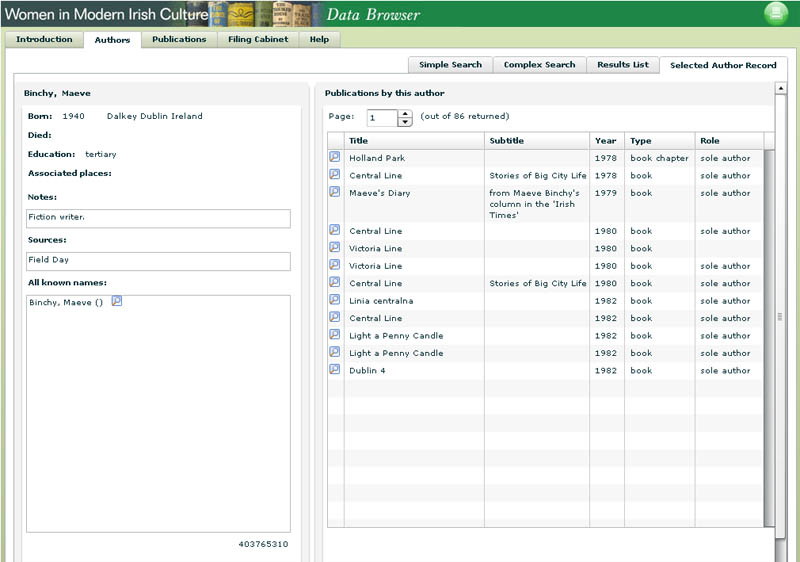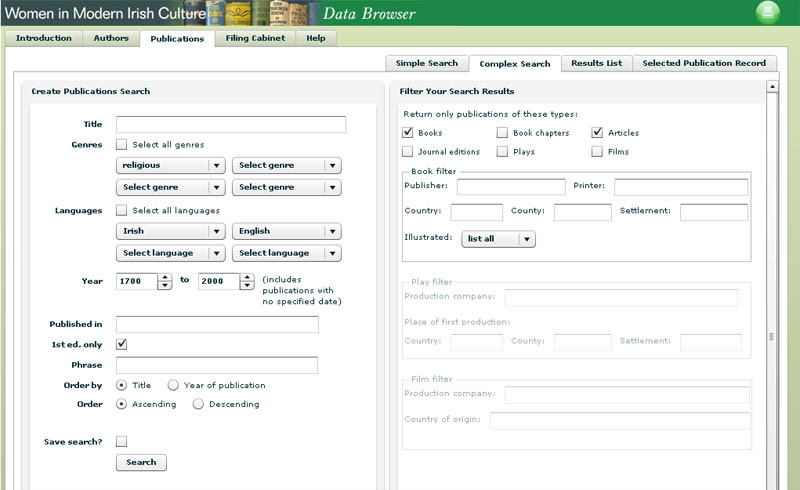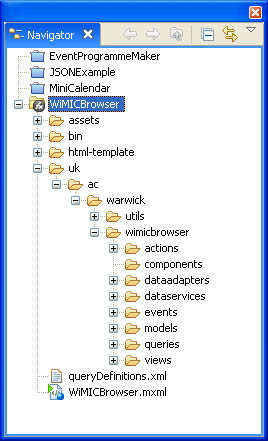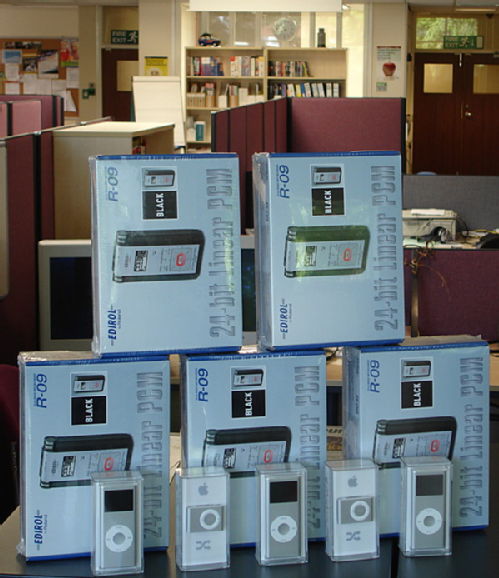All 23 entries tagged Elearning
View all 65 entries tagged Elearning on Warwick Blogs | View entries tagged Elearning at Technorati | There are no images tagged Elearning on this blog
June 29, 2009
My new research blog: Inspires Learning
I will be publishing all future entries concerning space, pedagogy, technology and design on my new blog at http://www.inspireslearning.com
February 24, 2009
The Ikea effect – why we should build a flat–pack V[R]LE
For some time now my colleagues in the Warwick E-learning Advisor Team have been arguing that we should create some kind of 'templating' system within the web publishing component of our V[R]LE (Sitebuilder). Chris Coe has a great name for it: Elaborate (quick, file for a trademark).
The idea is that we could create templates based on generic and discipline specific learning designs. A template would embody the structure, functionality, and flow of the learning design in a set of pages and interactions. The template could then be copied and, following a set of instructions, filled-out with learning content. For example, there could be a template for a peer-review process. This could even be combined with a 'wizard' approach that builds the detail of the learning activity based upon answers provided by the learning designer (tutor) to a series of questions.
We justify this argument with these claims:
- Speed and efficiency;
- Promoting consistency and good practice;
- Developing a shared language for describing different learning designs;
- Giving a focus for evaluating different learning designs;
- Allowing us to tailor designs for departments and courses.
I've just discovered a further significant reason for working in this way, given in an article in the February 2009 edition of the Harvard Business Review:
The Ikea Effect: When Labor Leads to Love by Michael I. Norton of Duke University
...labor enhances affection for its results. When people construct products themselves, from bookshelves to Build-a-Bears, they come to overvalue their (often poorly made) creations.
The success of Ikea, they claim, is to some extent based upon the flat-pack principle - do much of the work for the customer, but allow them to feel as if they are still investing their labor (and hence their love) in the product. Perfect flat-pack makes people love you! And Ikea certainly do have some ingenious ways with flat-pack construction.
A templated learning-design is flat-pack.
Norton gives a warning: if the customer puts too much work into the construction, they may end up loving the product too much, thus making future change impossible.
The second rule of Ikea is to make the construction easy enough for the product to feel potentially disposable.
The same must be true of learning activities built from a template.
But what of customisation? We know that people love to customise. Indeed, Ikea offer that to some extent, but the customisation is never fundamental - it's simply a matter of combining products and adding ornaments (that's why they sell cheap bits and pieces from which they can't possibly profit).
So then, how to build a V[R]LE that is used and cherished by the masses: use the Ikea effect.
If you're involved in building learning content, or are interested in the construction of V[R]LEs, you are welcome to comment on this idea.
Update: I've just thought of another reason why templating is good. Here's the use case:
- Tutor A creates a useful template.
- Other tutors in their department see the pages created from the template, and want to do similarly.
- Each page is marked with "Created using the template TEMPLATE NAME, designed by PERSONS NAME .
- The tutors can then create their own pages using the template, and get advice Tutor A.
October 06, 2008
Using the Teaching Grid for 'hub–and–spoke' style teaching
In the past, all of these sessions have been taught in conventional IT training rooms (rows of PCs facing a screen with a data projector). However, there is a significant ‘theoretical’ element to the task: a set of analytical, investigative, conceptual tools and behaviours that must be mastered in order to create an effective design within the given constraints: the students must learn to think and act as design and communication professionals, with the addition of a reflective academic perspective. The traditional IT room is unsuited to these more challenging aims. To effectively acquire and practice these skills, the students should be able to:
- frequently present their designs to each other for feedback, engage in creative processes, such as drawing on whiteboards, conducting interviews, acting out scenarios;
- seek mutual confirmation of understanding, especially when undertaking complex tasks and using abstract concepts;
- exhibit the products of the design process for peer (simulated client) review (in the last session).
The environment in which this happens must enable the students to behave as:
- design and communication professionals;
- investigative, reflective academics.
The high proportion of students with English as a foreign language also makes such collaborative working valuable. However, with many of the students coming from the tradition of didactic content transmission, establishing the required practices and attitudes is problematic. I actively resist being drawn back into a traditional lecture mode, and am therefore keen to use an environment that strongly supports active, investigative, collaborative learning. However, given the steep multi-dimensional learning curve that is required, I must also be sensitive to the need to continually provide clear models of the many new and challenging behaviours that I demand from the students. There is therefore a tension between encouraging student beahviour of the kind described above, and the need to continually provide clear exemplars. To address this conflict, I use online tools and a ‘hub-and-spoke’ classroom working arrangement.
The online tools are constructed from a combination of resources that can be used independently at any time, and a session plan (on a single web page) putting some of these resources into context and setting challenges to the students, the solutions to which may use the resources. The session plan web page was used throughout the session, both by me at the central ‘hub’ location, and by the students in small groups as they dispersed into the ‘spokes’. In the first session, the resources included a 7 minute video of a discussion between myself and Jonathan Vickery (explaining the purpose of the sessions), as well as an extensive glossary of key design and communication terms, relevant to the many issues that the students must consider.
The ‘hub and spoke’ physical organisation aims to provide a central location at which new ideas and practices can be introduced and modelled (hub), and a series of student team workareas (spokes) at which small groups of students can work indepedently to experiment and apply what they have seen. For this to work effectively, it should be easy to bring the focus of the session back from the spokes to the hub. It should also be possible to invite students to bring their work from the spokes to the hub and demonstrate it back to the rest of the class. A further possibility is for students from one spoke to visit students in another spoke.
In searching for a more appropriate learning space in which this could take place, I based the first session in the Teaching Grid experimental teaching space. The final session, in which the students will exhibit their e-portfolios, will return to the Teaching Grid, with the intervening sessions taking place in a traditional IT training room. It would have been preferable to hold the first two sessions in the Teaching Grid, allowing the more challenging activities to be undertaken in a longer time, however, the room was not available.
The space available to us in the Teaching Grid does not completely support the ‘hub-and-spoke’ learning design when used with 25 students. Using glass and curtain partitions, it can be divided into four small spaces each capable of accomodating six students with a laptop and large screen (two spaces with LCD smart boards, two with data projectors). It also proved possible to merge two of these spaces at one end into one, so as to accomodate all 25 students. However, there is no separate ‘hub’ location that can be viewed by all four groups in situ. To reconvene all 25 students in one place required their work to be disrupted and two of the spaces to be reconfigured. I attempted to compensate for this by putting some of the hub activities into the session plan web page as text, to be used independently by the students in the spoke locations. This is obviously a much less effective, less personal, less flexible, less controlled approach than demonstrating from the hub position: seriously detrimental to the effectiveness of the session.
The session was divided into three segments, intended to last around 40 minutes each. In the first segment, with the students gathered into a double work space and facing a large screen, I introduced the module web site, the glossary, and the session plan page. I then played the introductory video. This worked well, being a relatively conventional activity. We then spent a short time diviiding into groups using a voluntary method. It would have been better to have had the groups pre-assigned, and better still to have had the students already seated in their groups at the spoke locations all viewing the central hub.
The second segment was much more challenging, with each group being given the task of working through sequences of glossary terms, and then applying those terms to their own e-portfolio design process. The new Sitebuilder glossary system worked wonderfully, allowing me to quickly build a resource to which we we return constantly during the module. Modelling from the central hub would have made a significant difference to this series of difficult tasks. I was able to easily walk between groups to offer additional support, but found myself to be repeating explanations for each group.
Finally, each group was tasked with designing an e-portfolio for a client (me). They were able to get paper and pens, and had access to the computers for researching the client. Some students tried to use the electronic whiteboard but struggled. Other students used to video cameras that I provided (Sanyo Xacti HD) to interview the client. The final presentations were caried out in one of the spaces, with students able to watch from the space outside. This was entirely paper based. Given more time, it would have been better for the students to create a digital presentation combining video, audio, text and images. Stretching the activiites over two weeks would have enabled this.
August 27, 2008
Want to get people interacting on your web site: blog or forum?
Ignore the underlying technology for a moment, and instead consider blogs and forums as different media. Each has a different pattern of interaction and ownership.
A blog usually belongs to a single person. Or in some cases, a small group of people. The main body of content on the blog is the responsibility of that person. That might mean that they write the content themselves, or that they act as a kind of editor/reviewer presenting someone else’s content. A blog also consists of relatively substantial individual entries, which may or may not prompt a discussion (the blog owner has editorial control of the discussion). The discussion might then involve a wider range of people. The quality of a blog largely depends upon the main blog entries, although that quality might then be enhanced by the subsequent discussion. Some successful blogs contain no discursive element. For most blogs, the role of discursive content varies over time.
A forum is very different. It is owned by all of its participants (although there may be editorial control imposed by a moderator). Forums are built out of shorter discursive exchanges. They are driven by a group of individuals, each sharing a strong need for such exchanges. Without that need, the forum will fail. A further drawback is that a dialog built out of lots of small exchanges is likely to fragment. Some forums avoid this because their participants have a good shared understanding, and are already driven to collaborate effectively. Other forums work because they are driven by an effective moderator-tutor.
Which would I recommend? Unless you already have the kind of community that I describe as necessary for a forum, you should probably go with a blog. To make the blog work, you will need to regularly add entries that are substantial and interesting enough to provoke a worthy discussion. One further possibility would be to invite selected members of your target audience to write entries for the blog, so that it works a little like an edited journal.
An additional thought: perhaps in an ideal world, a blog entry could more fluidly connect to an existing discussion forum, web page, video etc.July 09, 2008
Virtual Learning Environment benchmarking workshop
We have a nice shiny new experimental teaching space called the Teaching Grid. It has lots of projectors, nicely spaced out, with moveable partitions that can be used to create separate zones. My idea is this:
- Divide the room up into 6 zones, each with a screen, PC and projector.
- In each zone, display one of 6 different VLEs (WebCT, Blackboard, Moodle, Sakai, Sitebuilder/Warwick Blogs, and WebLearn/Boddington).
- Have a team of VLE users (teachers and students) & admins for each of the 6.
- Create a matrix of requirements, features, design patterns, and analyse each one accordingly.
- Present a list of 5 best aspects of each one.
- Allow each of the 6 teams to visit all of the others.
There will also be a “beyond the VLE” section, for features and design patterns that don’t exist in any of the VLEs.
We have the technology. I can get money for a lavish(!) buffet. All I need are representatives from unis that use each of the systems.
I’m aiming for mid-September 2008 for this.
Anyone interested?March 19, 2008
Interview with Peter Kirwan, succesful student blogger
A great result. When Kay Sanderson and I first promoted the idea of academic blogging in 2003 we had hoped that it would help students in just this way: becoming active and self-reflective writers, and becoming part of the research and cultural process.
Created using an Apple MacBook, with the built-in camera. Recorded and edited with iMovie. Screen captures created in Screenflow. Converted to FLV format using Flix.
February 11, 2008
16 ways to make an excellent university
Here’s my list. It’s not intended to be exclusively complete, but rather to give a basic framework.
- Create, promote and review many diverse opportunities and resources.
- Reduce the burden of admin and bureaucracy.
- Enable and encourage enterprise.
- Provide space, tools and resources for creativity.
- Support managed risk taking.
- Support deep-learning and specialisation, within an understanding of wider contexts and connections.
- Establish a range of alternative channels of expression and collaboration, to be used intelligently, with purpose and discretion.
- Create and sustain meaningful communities at the appropriate scale and of the appropriate form.
- Facilitate international and local perspectives and connections as part of all activities.
- Form mutually beneficial collaborations that bring together diverse people (varying status, age, skills level, intellectual and cultural background etc).
- Develop, communicate and use appropriate and well defined values: benchmarks; standards; competencies (assessment).
- Enable and encourage the critical reflection, planning & action cycle.
- Identify and reward individual contributions, capabilities and achievements.
- Share examples, testimonies, methods and stories.
- Communicate and celebrate success.
- Provide an enjoyable, caring and friendly experience.
February 10, 2008
More trivial uses of the blog video recorder
So far only one person has been brave enough to perform on Warwick Blogs…
This was recorded directly into the blog entry using the new blog video recorder and a web cam: now a standard feature of Warwick Blogs, thanks to the ingenious Mr Carpenter.
Internet Explorer users may need to click the video twice to play it.
August 28, 2007
Robert O'Toole E–learning Advisor CV statement
Learning technology and learning design consultant
I have ten years of experience in the application of learning technologies to enhance and extend teaching, both in-class and online. This includes three years at the University of Oxford (1998 to 2001) and five years at the University of Warwick (2002 to present). I am currently the Arts Faculty E-learning Advisor at Warwick.
I work closely with faculty and students to identify, implement and review appropriate enhancements to existing practices. My work ‘in the field’ feeds back into the work of our applications development team, who have built an advanced and in some ways unique e-learning infrastructure, responding to the needs of the university. I am developing a patterns based approach to learning design.
The E-learning Advisor Team also undertakes development projects in order to investigate and report upon new techniques and technologies. For example, we are developing innovative online conferencing tools to support the syndication pattern employed by, amongst others, the Warwick Business School.
Teacher and technology coach
- I am a trained, qualified and experienced teacher of information and communications technology (Postgraduate Certificate in Education, University of Warwick, 1996).
- I have taught all kinds of people, ranging from school children to professors.
- Much of my work in recent years has been with graduate students, and has focussed upon using technology to enhance communications, research, planning and enterprise.
- My teaching is often within the context of group and individual development, with participants focussing upon the development of tangible and useable end products.
- I use a wide range of techniques, including individual coaching, project work, experiental and simulation activities, and large interactive lectures. I blend on-site and online activities where appropriate.
- I have designed module, course and programme level curricula.
Software developer
I am now specialising in Rich Internet Applications using Adobe Flex/Flash. I have also worked extensively with SQL databases, XML, Javascript and Java. I employ a patterns-based approach to analysis and design, with an agile customer focussed development process.
I am particularly experienced in developing applications that support the research and analysis process.
My developing skills
- Technical and creative writing;
- Broadcast and print journalism and production;
- Team leadership;
- Business analysis;
- Marketing.
My other interests
I have a first class degree in philosophy from the University of Warwick, and continue my interest in this and related fields including cognitive science and educational theory. I also have an MSc in Knowledge Based Systems from the University of Sussex.
I am also interested in travel writing and journal writing.July 17, 2007
WiMIC Browser – my first big Flex application
Writing about web page http://www2.warwick.ac.uk/fac/arts/history/irishwomenwriters/







What then do I think of Flex and RIA technologies? Yes, at last we can easily and safely build complex web applications that run well on [m]any different platforms.
June 22, 2007
Interview with winning student podcaster
Follow-up to Warwick Podcasts Competition finale from Transversality - Robert O'Toole
My interview sought to examine the process of creating the podcast, with an emphasis upon the contribution of the activity to the development of Manu and Raj’s academic skills. Significant skills work was identified in the following areas:
- Team working – the students organized themselves into a small production team, identifying the required roles and allocating them with consideration of skills and interests.
- Research – as Manu makes clear, preparing effectively with a sound understanding of the subject area and the interviewee was essential.
- Accessing and using archive material – particularly relevant to a podcast dealing with historical events.
- Awareness of the audience – consideration was given as to how to produce a podcast that could be listenable for 15 minutes. The use of a small and well placed degree of humour worked particularly well.
- Synthesis and analysis of a range of ideas, arguments and materials. Very much an audio essay.
- Academic and interpersonal sensitivity – being aware of difficult areas, and approaching them carefully.
- Identifying and highlighting key points.
- Technical skills – recording, editing and publishing.
Two areas of difficulty were identified:
- Finding and accessing the required audio resources.
- Understanding and applying the relevant copyright and IPR practices.
These are particularly problematic areas, for which we should provide more support.
A further lesson to be taken from the interview is that, with the availability of user friendly software (Apple Garage Band), editing can be easy and can add to the academic process. For example, Manu and Raj replaced a long and too imprecise question with a shorter alternative more suited to the answer given by the interviewee. This is contrary to the advice given to the competition participants, as I warned them to avoid editing. However, few of them had access to such good software.
I conclude that this case substantiates my claim that student podcasting and interviewing is a valuable addition to research based learning approaches. In addition, I also believe that it adds some support to more radical conjectures:
- That an audio production of this kind is in many ways equivalent to a written essay.
- That as a skills and academic development task it is much better than the traditional seminar presentation, but still within the ability level of the average student.
- That podcasting can improve student self-confidence.
- That reconsidering the academic process as being a production process analogous to the production of a “programme” provides the participants with a more tangible and user friendly product with which they can be more involved and responsible.
June 15, 2007
Warwick Podcasts Competition finale
Follow-up to More free iPods and MP3 recorders from Transversality - Robert O'Toole
You can read about the proposed podcasts at: http://www2.warwick.ac.uk/services/elearning/podcasts/competitors/
And the finished work will be uploaded to: http://www2.warwick.ac.uk/services/elearning/podcasts/entries/
Winners will be announced and prizes awarded as part of a “champagne reception” at the end of the e-learning showcase day. If you are attending the Showcase Day, you are welcome to come to the awards ceremony.
To find out more about podcasting, come along to one of the Showcase Day sessions, or contact:
Tom Abbott (Communications Office)
Robert O’Toole (Arts Faculty)
Chris Coe (Social Sciences)
Steve Carpenter (Science and Engineering)
Stephen Brydges (Medical School)
May 25, 2007
More free iPods and MP3 recorders
Follow-up to Free iPods and professional MP3 recorders from Transversality - Robert O'Toole
Thanks again to the Alumni and Development Office, the EIF and the Communications Office for providing sponsorship. As you can see, I have quite a few MP3 recorders to give away as part of the Warwick Podcasts Competition.

Mr Stevens is obviously bored.
May 23, 2007
Free iPods and professional MP3 recorders
Follow-up to Warwick Podcasts Competition open now from Transversality - Robert O'Toole

I now have an impressive stack of iPods and Edirol MP3 recorders to give away for free – well almost free. This photo shows how a small pyramid can be constructed from just a few of them.
To find out more, see the Warwick Podcasts Competition page.
 Robert O'Toole
Robert O'Toole

 Please wait - comments are loading
Please wait - comments are loading